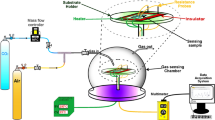Abstract
Tungsten trioxide and two types of tin dioxide were compacted at different pressures and then sintered at different temperatures in order to study how the microstructure formed is dependent on these parameters. The structures were studied using dilatometric and porosimetric techniques and also using electron microscopy. X-ray diffraction was used to ascertain the completeness of the decomposition reaction of SnSO4 being converted to SnO2. Tin dioxide, which was prepared from tin sulphate by calcining, was characterised by a large specific surface area. For all three materials studied the mean pore size was found to increase and the specific surface area was found to decrease with increasing sintering temperature. In the case of WO3 the total pore volume decreased markedly as the sintering temperature was increased from 900 to 1000° C. However, in the case of SnO2, the total pore volume remained almost constant in the sintering temperature range of 600 to 1500° C. In the case of SnO2 derived from SnSO4 the sintered density was about 45% of the theoretical value while for the conventionally made SnO2 the sintered density was about 55% of the theoretical value. The sintered density of WO3 was found to show a marked increase, from 55% to 70% of the theoretical value, as the sintering temperature was raised from 1000 to 1100° C.
Similar content being viewed by others
References
T. Nomura and Y. Yamaguchi, Am. Ceram. Soc. Bull.59, 453 (1980).
Y. Enomoto and A. Yamaji, Am. Ceram. Soc. Bull.60, 566 (1981).
0. J. Whittemore, Jr., Mat. Sci. Res.11, 125 (1978).
0. J. Whittemore, Jr. and J. J. Sipe, Powder Technol.9, 159 (1974).
H. D. Joss, M. S. Thesis, Univ. of Washington, Seattle, (1975).
K. Murakami, S. Yasunaga, S. Sunahara, K. Ihokura, Analytical Chemistry Symposia Series17, 18 (1983).
G. S. V. Coles, K. J. Gallagher, J. Watson, Sensors and Actuators 7, 89 (1985).
Author information
Authors and Affiliations
Rights and permissions
About this article
Cite this article
Torvela, H., Jaakola, T., Uusimäki, A. et al. Processing characteristics of tin and tungsten oxides relevant to production of gas sensors. J. Electron. Mater. 15, 7–11 (1986). https://doi.org/10.1007/BF02649943
Received:
Issue Date:
DOI: https://doi.org/10.1007/BF02649943



